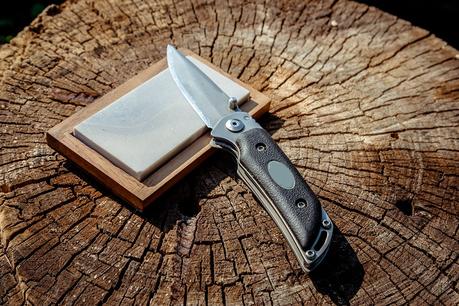
Survival knives are pretty handy in the wild, and a pocket knife is no different. It comes in handy mainly due to its accessibility and the fact that it can be used for so many purposes.
Today, it is no surprise to see a pocket knife being used to carve wood, cut boxes, poke at bags, and open food packages. Most people who own pocket knives, however, don’t pay attention to the nature of the blade and most of them will be carrying around a dull knife.
Just like a dull kitchen knife, a dull pocket knife takes more force to use, which is why you need to sharpen it every once in a while if you use it a lot of times.
Sharpening a pocket knife takes only a few minutes and there are so many tools that you can use on the market. If you go hunting, fishing or camping every once in a while, a dull knife should not be in your equation because you will need it in the wild.
What Is a Pocket Knife
A pocket knife is a knife that has one or more blades that are designed to fold into the handle. Just as the name suggests, a pocket knife can be carried in the pocket and comes in handy in a lot of sticky situations.
Also known as a penknife or a jackknife, a pocket knife is a multilateral tool that can be used for everything from cutting off tags on clothes to opening packages and, in some cases, self-defense.
There are so many types of pocket knives that you can find in hardware stores and online shops. Prices differ based on the brand and what the knife is intended for.
Small but yet functional, a pocket knife is the best tool you can get if you are an outdoor person. Whether for survival or just to carry around, a pocket knife can be essential for some people and precious for some.
Just like with a premium hunting knife, anyone from a military man, woodworker, contractor to an outdoorsman can make use of a pocket knife at some point. The foldable design, combined with the easy to use handle increases the usability of a pocket knife.
Benefits of Using a Pocket Knife
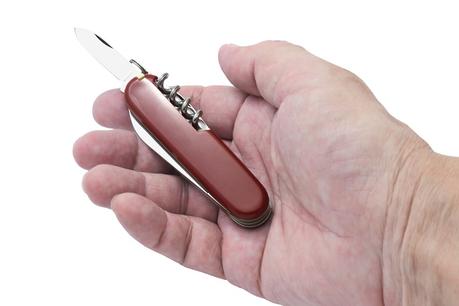
Long gone are the days when knives were only considered as tools that can only be used in the kitchen. With technological advancements, knives have turned into impoverished tools that can be used anywhere. Just like you would go trout fishing with a spinning rod, here are a few benefits of pocket knives that you need to be aware of.
Survival in the Wild
If you are always out in the wild, there is no better tool that you can bring with you on that hiking or camping trip than a pocket knife. The last thing you need is to carry a large knife or worse a machete that will not fit in your hunting backpack with safety straps.
If you take a range bag, you want to carry something that is small enough to fit in your luggage or pocket and can still be used as a large knife and that’s where pocket knives come in. You can use a pocket knife in the wild for almost anything from cutting kindling, to setting up a tent, handling fires and cutting up food.
Additionally, you can even use a pocket knife to make fire by just making a spark with the touch of the knife with a stone. Even when going fishing, a pocket knife will come in handy in helping you cut line after catching a big fish or to remove the hook from a fish.
Preparing Food
While some people think that this is dangerous, if you don’t have utensils, a pocket knife will go a long way. Whether you require a spoon, fork or a knife, a pocket knife can do everything these tools can do when preparing and handling food.
DIY Projects and Woodwork
Most people assume that a pocket knife will only come in handy when the situation arises, but this couldn’t be further from the truth.
A pocket knife can be part of the tools for your workshop projects. Additionally, the ability to make clean cuts and fit in the pocket makes it a reliable tool when it comes to DIY projects.
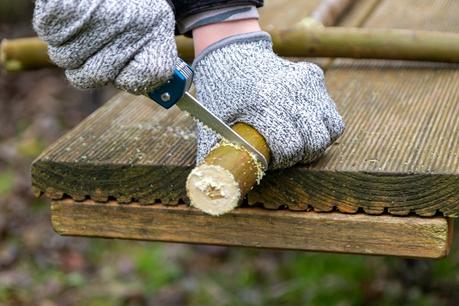
Trimming Clothes
This is useful to those in the retail and fashion industries. The ability of the pocket knife to make alterations on fabrics makes it a useful tool to have.
This way, you don’t have to use a large knife that can lead to accidents. A pocket knife is also useful in sticky situations like when someone breaks a limb or suffers a deep cut in any part that is covered by clothes. When that happens, you can use a pocket knife to cut through their clothing so that you can free the wound for treatment.
Self-Defense
For those who go camping, fishing or hiking, there are so many things that you need to bring with you like boots for hunting with a rubber sole. A pocket knife will come in handy when you need to protect yourself from an intruder or a wild animal.
First Aid and Emergencies
While a first aid kit would be ideal in treating a wound or any other injury, you may not have a first aid kit with you all the time. In such a case, a pocket knife can be useful in such emergencies.
Whether it’s’s retrieving splinters from wounds or ripping clothes off in case of an injury, a pocket knife is all you need. Additionally, you can use a pocket knife to carve messages in rocks or trees in case you end up getting lost in the wild.
Portable and Versatile
The good thing about a pocket knife and maybe the main reason why people buy them is that they can be taken anywhere and can fit in anything from your pocket, bag to a pouch.
The fact that they are small makes portability easy and the fact that they can be used in so many situations makes them versatile.
Durability and Resistance
A high-quality pocket knife can last you for decades. For instance, a pocket knife made of stainless steel does not erode or wear down with time.
Even if such a knife comes into contact with water or other fluids, its looks and usability will not be affected. Additionally, pocket knives can also be used for heavy-duty applications without breaking.
Convenience
A majority of pocket knives tend to be simple with a single foldable blade that can be used to cut anything or trim stuff when the situation arises. You can use a pocket knife for anything without worrying about the blade breaking. However, a multi-tool pocket knife is way better.
Some pocket knives also come with a nail polisher, screwdriver or a corkscrew, which makes them versatile. If the knife comes with only a blade, you can still use it for several tasks. To get value for your money, you need to consider the design of the knife and the tools that come with it.
How Does a Pocket Knife Work
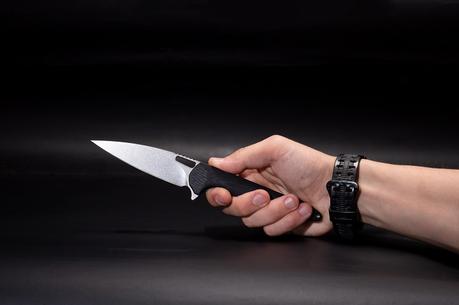
While some people think that carrying a pocket knife is dangerous, it can come in handy in so many situations. When it comes to an understanding of how pocket knives work, you need to understand the different opening mechanisms.
The speed and comfort with which you engage a pocket knife can make all the difference in a sticky situation. First, manual opening blades have been around for decades and just as the name suggests, such knives are opened with your hands.
There are several methods of manual opening and they include the nail nick and the thumb stud, which is a protrusion in the blade that makes it easy to open the knife with your thumb.
The other opening mechanism is automatic or switchblade. The switchblade is engaged with the push of a button or a switch. The assisted opening mechanism is the final opening mechanism of pocket knives. An assisted opening knife usually has an internal device that engages the blade when pressure is applied to the knife.
The difference between an assisted opener and a switchblade is that a switchblade normally has a bias towards being open while the assisted opener needs force to be opened.
Tools for Sharpening a Pocket Knife
Just like coyote calls are a useful tool to have in the wild or a kayak compass will help navigate you when you are angling, there are different tools that you can use to sharpen your pocket knife from sharpening stones, lubricant to honing rods.
Sharpening Stone
Just like there are so many ways to sharpen a pocket knife, there is a variety of sharpening stones that you will find on the market from whetstone, ceramic stones to diamond stones.
Choosing a sharpening stone depends on how you intend to use it and your personal preferences. You can try out different kinds of stones to find the one that works perfectly for you.
If you are sharpening high-quality knives, the last thing you want to use is a cheapo stone. However, if you are just getting started, you don’t need to spend too much on a fancy sharpening stone.
Sharpening stones can be purchased in most hardware stores and they cost from $10 for the basic ones. A majority of sharpening stones come with two sides, fine grit and a rough grit. The finer the grit, the sharper or finer your blade will get.
When using a sharpening stone, start sharpening on the rough grip and finish off with the fine grit to get the knife as sharp as possible.
Lubricant
A majority of knife sharpening experts recommend using lubricant when you are sharpening your knife. Lubricants come in different forms, from oil to water.
A majority of experts out there, however, recommend using mineral oil to sharpen your knife. The lubricant is meant to reduce heat from the friction generated when you are sharpening the knife.
Too much heat usually causes the blade to warp. Lubrication also helps in clearing out debris or swarf that is created as the blade grinds on the stone.
Lubrication can be bought at any hardware store and costs from $5. One thing to note, however, is that lubrication is not usually necessary with a majority of basic sharpening stones. As such, if you are in the wild and need to sharpen your knife, don’t let lack of lubrication ruin your trip.
Honing Rod
Horning rods are known as sharpening steel. While rods will sharpen your knife, what they do is hone the blade with the same results as sharpening the knife on a stone.
There are different kinds of honing rods, with the most common being a steel honing rod. Also known as a sharpening steel. Honing rods can be made out of a diamond or ceramic materials that are both reliable since they are the hardest materials in the world.
Diamond rods, however, create smoother blades, but at the end of the day, both will quickly sharpen your pocket knife when you need to.
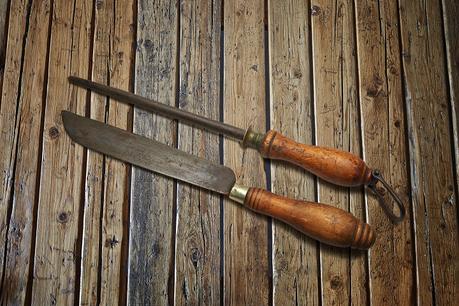
How to Sharpen a Pocket Knife With a Stone
Step 1 – Lubricate the stone
The first thing you need to do before you sharpen your knife is to wet your sharpening stone. If your stone has two sides, start with the rough side.
Step 2 – Set the angle
It is recommended that you hold the blade when you are sharpening the knife. The angle in which you hold the knife will depend on the knife and it can be anywhere from 15 degrees to 30. To get the bevel angle, you must practice until you get the feel.
Step 3 – Sharpen the rough side
Set the blade at the perfect angle and then try and hold the knife at the same position. After that, start with the position at the end of the sharpening stone such that the blade is facing away from you.
Pull the pocket knife towards you. Now reach the end and glide the razor down such that you hit any curved side of the blade. Repeat this 15 times and then flip over and repeat.
Step 4 – Sharpen the fine side
After you are done sharpening the rough side, sharpen the fine side using the same process.
Step 5 – Clean the blade
Use a towel to wipe the blades gently, making sure not to injure yourself in the process.
Step 6 – Test the sharpness of the knife
You can do this by either slicing paper, shaving sharp, slicing an onion or magazines and phone book covers. If your knife can slice effortlessly such that it doesn’t tear or catch paper, then you are good to go. Additionally, if you can shave your arm hair effortlessly, it means that the knife is sharp enough.
How to Sharpen a Pocket Knife With a Honing Rod
Step 1 – Hold the rod by the handle
To be safe, place the tip of an old towel on top of the cutting board or chopping block. This is important if you don’t want to leave gashes on the countertops or dull your knife in the process. The rod should be held straight up and down such that it stays perfectly vertical.
Step 2 – Find the bevel angle
Again, you need to determine the angle at which you need to hold the blade against the rod. Generally, pocket knives should be held at a 25 to 30-degree angle.
Step 3 – Swipe the edge along the rod
Swipe the edge of the knife slowly and use a light touch and avoid pushing the knife against the rod with a lot of pressure. Move the knife from the heel to the tip and maintain the same angle with every stroke.
Step 4 – Switch sides
Switch the sides to ensure that you hone both sides of the knife. If the knife is relatively sharp, you only need to swipe it along the rod a couple of times on both sides. If it is very dull, you may have to swipe the knife several times to achieve the desired sharpness.
How to Sharpen a Pocket Knife With Serrated Edges
Just like electric knives for fillet cleaning, serrated knives usually hold their edge longer than straight-edged knives, but they are much more difficult to restore without altering the shape. As such, it is important that you only sharpen such a knife when you notice that it has become less effective.
Step 1 – Locate the side of the knife with a beveled edge
Serrated knives don’t look the same from both sides. On one side, the face of the blade continues at some angle until the edge of the blade, while on the other, the blade angles down slightly just before the serrated edge, which is referred to as bevel. You only need to apply the sharpening tool to the beveled edge with such a knife.
Step 2 – Place the sharpening rod in a serrated scallop
Choosing an angle with a serrated knife is easy since you can use the angle of the bevel. This is between 13 to 17 degrees.
Step 3 – Move the rod
Next, move the rod to match the gullet’s diameter. If the sharpening rod you are using is tapered, locate the rod in the gullet.
Step 4 – Sharpen the first gullet
Run the rod along the first grove in short strokes. Push in one direction away from the blade’s edge towards the spine. Rotate the rod as you push for an even grind.
Step 5 – Check for burr
Run your fingers along the backside of the groove to check for a burr. If you feel any burr, your groove is sharpened well.
Step 6 – Continue sharpening each groove
If the serrations are of different sizes, adjust the position of the sharpening rod such that the rod just fills the groove.
Step 7 – File away all burrs
The burrs are usually the metal shavings that you file off when you are sharpening the blade. Remove them by rubbing the back of the knife against fine-grit sandpaper or run the sharpening rod against the backside of the grooves.
Step 8 – Straighten any straight-edged potion
If your pocket knife is serrated only along a part of the length of the blade, sharpen the remaining length with a sharpening tool or whetstone. Under no circumstance should you use the serrated knife sharpener to sharpen the straight edges of the blade.
How to Sharpen a Pocket Knife With Household Items
What happens if you don’t have a sharpening stone but need to sharpen your pocket knife anyway?
Just like you would bring the world’s best lunch cooler with you on a camping or fishing trip, there are several household items that you might use to sharpen your pocket knife.
Step 1 – Coffee mug
All houses have ceramic mugs. Spin the cup upside down and find the raw side of the mug. Once you have found it, move the blade across the mug.
If it’s working, there should be small defects on the mug, which means that the ceramic is removing steel and sharpening your blade.
Step 2 – Scissors
Look for good scissors and set the angle of the pocket knife. Close your scissors until you get an edge that you want. Move the knife back and run a few times pressing steadily against the scissors.
The best angle is 70 degrees. Lay the knife on the nail of your thumb. If it happens to stick, then the edge is well sharpened.
Step 3 – Leather belt
Find a leather belt that has no stitching and then move the knife away from the cutting edge over the blade.
Step 4 – Nail file
Put the nail file on a smooth surface and move the blade along the rough board a couple of times.
Step 5 – Nylon strap
If you don’t own a leather belt, you can use a nylon strap. Move the blade of the knife against the nylon strap and away from the cutting edge.
Do’s and Don’ts With a Pocket Knife
- Do keep your pocket knife dry at all times. Leaving the blade wet with water or acid can build rust and will eventually degrade the blade’s edge.
- Do hone your pocket knife regularly to align the apex of the blade keeping the blade’s edge sharp.
- Do always keep the blade covered to ensure that the knife doesn’t get nicked by other utensils and surfaces or worse injure you.
- Don’t cut frozen food with the knife. While Japanese steel is hard, it is not supposed to come into contact with frozen solids. As such, know the purpose of your knife and avoid hacking into bones, ice, and frozen food to avoid damaging the blade’s edge.
- Don’t use hard plastic or glass cutting boards because these can damage the blade. Rather stick to cork and wood boards instead.
- Don’t ever put your pocket knife in a dishwasher since the harsh chemicals and extreme heat will damage your knife.
FAQ About Sharpening Pocket Knives
Can I use a kitchen knife sharpener on a pocket knife?
Yes, you can if you don’t have a sharpening stone with you. Just ensure that you hold the blade at the right angle when you are sharpening.
How often should you sharpen a pocket knife?
This depends on how often you use your knife, but with proper care and maintenance, you can go for 3 to 6 months without sharpening it.
Can you use a brick to sharpen a knife?
Any smooth surface can be used to sharpen a pocket knife and as it happens, bricks are made of ceramic, which is one of the materials used to make sharpening tools.
Do I need to strop a knife after honing?
It is not a must, but it cleans up any burrs and makes your knife sharper. Once a knife has been sharpened, you can strop to align the edges and help the knife cut.
How do I know when to sharpen my knife?
If the edges look round and shiny when the knife is held against the light, then it means that it needs sharpening. Logically, if the knife feels dull when cutting, it means that you need to sharpen it.
How do I sharpen the top of the knife?
You can use a rock that is not chalky like a slake rock. Put the knife at an angle such that it is pointing away from you and push down until you get to the point of the pocket knife. Do this on both sides to get a good sharp edge.
Conclusion
A pocket knife comes in handy when you are fishing, hunting, hiking or even at home for DIY projects. However, a dull pocket knife will not be of any use, which is why you need to ensure that you know how to sharpen yours when it gets dull. There are so many things you can use from sharpening stones, lubricant to a honing rod. When you are sharpening the knife, ensure that you use the same angle every time and ensure that you test the sharpness before you use the knife.
Photos from: Zysko / depositphotos.com, sunakri / depositphotos.com, vzwer / depositphotos.com, Bombaert / depositphotos.com and design56 / depositphotos.com.

